Let’s talk about the GC9A01A round LCD 240×240 display, a neat little addition to any hobbyists toolbox. We are talking about a 240×240 pixels RGB TFT LCD display in a round format. It talks to a microcontroller via SPI and can do 262k colors in full mode; 8 colors in idle mode.
Connections (hardware) are pretty straightforward, four data pins plus 3V3 and GND. Four resistors are necessary in series with the data pins because the display is 3V3 and Arduino runs at 5V. I used 680 Ohm resistors.

| GC9A01A display | Arduino UNO pin |
| RST | Not connected |
| CS | 10 |
| DC | 9 |
| SDA | 11 |
| SCL | 13 |
| GND | GND |
| VCC | 3V3 |
I started with a demonstration from this blog post. The code and picture are below, it is a voltage meter/gauge. Pretty complex stuff, the code is not mine.
#include "SPI.h"
#include "Adafruit_GC9A01A.h"
#define TFT_DC 9
#define TFT_CS 10
Adafruit_GC9A01A tft (TFT_CS, TFT_DC);
#define BLACK 0x0000 // some extra colors
#define BLUE 0x001F
#define RED 0xF800
#define GREEN 0x07E0
#define CYAN 0x07FF
#define MAGENTA 0xF81F
#define YELLOW 0xFFE0
#define WHITE 0xFFFF
#define ORANGE 0xFBE0
#define GREY 0x84B5
#define BORDEAUX 0xA000
#define AFRICA 0xAB21 // current dial color
#define DEG2RAD 0.0174532925
int multiplier;
int frametime = 1000;
int x_pos;
int y_pos;
int center_x = 120; // center x of dial on 240*240 TFT display
int center_y = 120; // center y of dial on 240*240 TFT display
float pivot_x, pivot_y,pivot_x_old, pivot_y_old;
float p1_x,p1_y,p2_x,p2_y,p3_x, p3_y, p4_x, p4_y, p5_x, p5_y;
float p1_x_old,p1_y_old, p2_x_old, p2_y_old, p3_x_old, p3_y_old;
float p4_x_old, p4_y_old, p5_x_old, p5_y_old;
float angleOffset = 3.14;
float arc_x;
float arc_y;
int radius = 120; // center y of circular scale
float angle_circle = 0;
float needleAngle = 0;
int iteration = 0;
int j;
float volt = 220;
int needle_multiplier = 1;
float needle_setter;
// voltage rolling averaging stuff
const byte nvalues = 10; // rolling average window size
static byte current = 0; // index for current value
static byte cvalues = 0; // count of values read (<= nvalues)
static float sum = 0; // rolling sum
static float values[nvalues];
float averagedVoltage = 235; // to start with
void setup() {
randomSeed (analogRead(0));
tft.begin();
Serial.begin (9600);
Serial.println ("");
Serial.println ("");
tft.setRotation (0);
tft.fillScreen (BLACK);
tft.drawCircle (center_x, center_y,120, BLACK);
pivot_x = center_x;
pivot_y = center_y+50;
p1_x_old = center_x; p1_y_old = center_y+50;
p2_x_old = center_x; p2_y_old = center_y+50;
p3_x_old = center_x; p3_y_old = center_y+50;
p4_x_old = center_x; p4_y_old = center_y+50;
p5_x_old = center_x; p5_y_old = center_y+50;
volt = 240; // initial value setting the needle
create_dial ();
needle_setter = volt;
needleAngle = (((needle_setter)*DEG2RAD*1.8)-3.14);
needle();
draw_pivot ();
}
void loop (){
iteration++;
Serial.println ();
Serial.print ("iteration ");
Serial.println (iteration);
volt = random (230,250); // voltage simulator
Serial.print ("simulated volt out of ZMPT101B: ");
Serial.println (volt);
averagedVoltage = movingAverage(volt);
Serial.print ("averaged volt = ");
Serial.println (averagedVoltage);
Serial.println ();
Serial.println ();
displayNumerical ();
needle_setter = averagedVoltage;
needle();
draw_pivot ();
delay (frametime);
}
void needle (){ // dynamic needle management
tft.drawLine (pivot_x, pivot_y, p1_x_old, p1_y_old, AFRICA); // remove old needle
tft.fillTriangle (p1_x_old, p1_y_old, p2_x_old, p2_y_old, p3_x_old, p3_y_old, AFRICA); // remove old arrow head
tft.fillTriangle (pivot_x, pivot_y, p4_x_old, p4_y_old, p5_x_old, p5_y_old, AFRICA); // remove old arrow head
needleAngle = (((needle_setter)*0.01745331*1.8)-3.14);
p1_x = (pivot_x + ((radius)*cos(needleAngle))); // needle tip
p1_y = (pivot_y + ((radius)*sin(needleAngle)));
p2_x = (pivot_x + ((radius-15)*cos(needleAngle-0.05))); // needle triange left
p2_y = (pivot_y + ((radius-15)*sin(needleAngle-0.05)));
p3_x = (pivot_x + ((radius-15)*cos(needleAngle+0.05))); // needle triange right
p3_y = (pivot_y + ((radius-15)*sin(needleAngle+0.05)));
p4_x = (pivot_x + ((radius-90)*cos(angleOffset+(needleAngle-0.2)))); // needle triange left
p4_y = (pivot_y + ((radius-90)*sin(angleOffset+(needleAngle-0.2))));
p5_x = (pivot_x + ((radius-90)*cos(angleOffset+(needleAngle+0.2)))); // needle triange right
p5_y = (pivot_y + ((radius-90)*sin(angleOffset+(needleAngle+0.2))));
p1_x_old = p1_x; p1_y_old = p1_y; // remember previous needle position
p2_x_old = p2_x; p2_y_old = p2_y;
p3_x_old = p3_x; p3_y_old = p3_y;
p4_x_old = p4_x; p4_y_old = p4_y; // remember previous needle counterweight position
p5_x_old = p5_x; p5_y_old = p5_y;
tft.drawLine (pivot_x, pivot_y, p1_x, p1_y, BLACK); // create needle
tft.fillTriangle (p1_x, p1_y, p2_x, p2_y, p3_x, p3_y, BLACK); // create needle tip pointer
tft.drawLine (center_x-80, center_y+70, center_x+80,center_y+70, WHITE); // repair floor
tft.fillTriangle (pivot_x, pivot_y, p4_x, p4_y, p5_x, p5_y, BLACK); // create needle counterweight
}
void create_dial (){
tft.fillCircle (center_x, center_y,120, AFRICA); // general dial field
tft.drawCircle (center_x, center_y,118,GREY);
tft.drawCircle (center_x, center_y,117,BLACK);
tft.drawCircle (center_x, center_y,116,BLACK);
tft.drawCircle (center_x, center_y,115,GREY);
for (j= 30; j<75 ; j+=5)
{
needleAngle = ((j*DEG2RAD*1.8)-3.14);
arc_x = (pivot_x + ((radius+15)*cos(needleAngle))); // needle tip
arc_y = (pivot_y + ((radius+15)*sin(needleAngle)));
tft.drawPixel (arc_x,arc_y,BLACK);
tft.fillCircle (arc_x,arc_y,2, BLACK);
}
tft.setTextColor (BLACK,AFRICA);
tft.setTextSize (2);
tft.setCursor (center_x+15, center_y+40);
tft.print ("V - AC");
tft.drawLine (center_x-80, center_y+70, center_x+80,center_y+70, WHITE); // create floor
}
void draw_pivot (){
tft.fillCircle (pivot_x, pivot_y,8,RED);
tft.drawCircle (pivot_x, pivot_y,8,BLACK);
tft.drawCircle (pivot_x, pivot_y,3,BLACK);
}
void displayNumerical (){
tft.fillRect (center_x-82, center_y+40, 62,16,AFRICA);
tft.setTextColor (BLACK);
tft.setTextSize (2);
tft.setCursor (center_x-80, center_y+40);
tft.print (averagedVoltage,1);
}
float movingAverage(float value) {
sum += value;
if (cvalues == nvalues) // if the window is full, adjust the sum by deleting the oldest value
sum -= values[current];
values[current] = value; // replace the oldest with the latest
if (++current >= nvalues)
current = 0;
if (cvalues < nvalues)
cvalues += 1;
return sum/cvalues;
}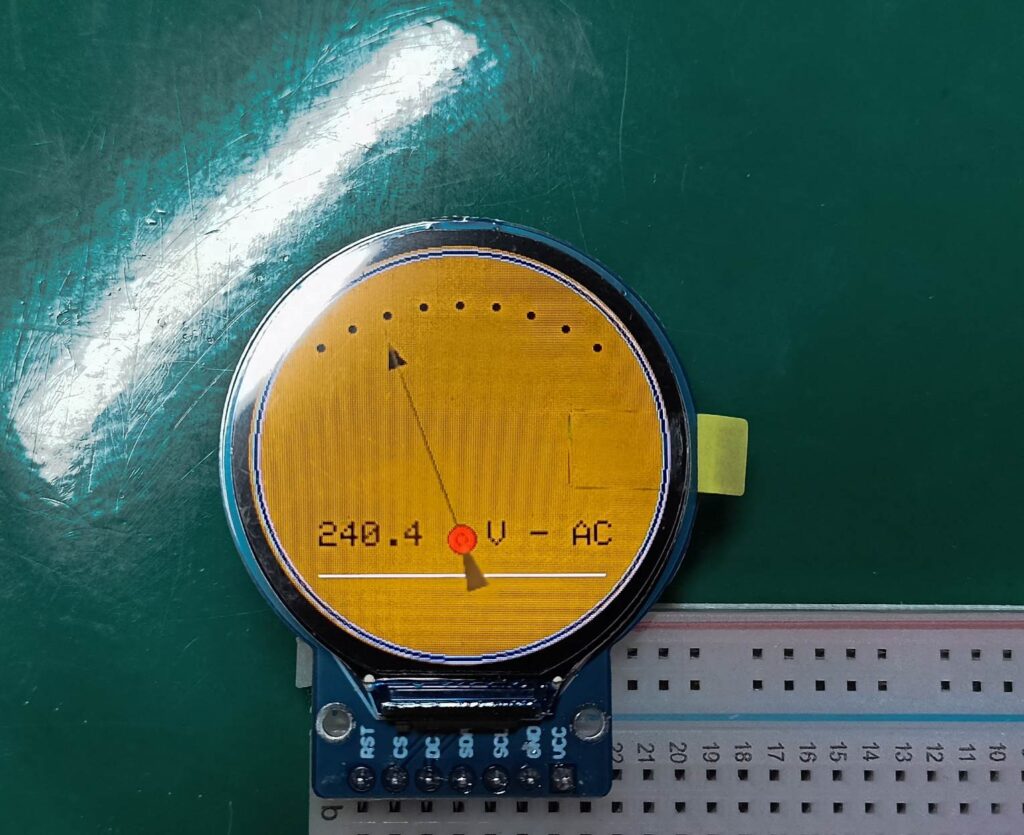
There is more information on the display, the GC9A01A datasheet is here.
The Adafruit library
I also ran the Adafruit demonstration from here (Github). For that you have first to install the official library in the Arduino IDE. Go “Sketch > Add library > Library manager” and type “GC9A01A”, select and install the Adafruit one. The image below is of one of the screen on the Adafruit library.
Code is accessible at the Arduino IDE on “File > Examples > Adafruit GC9A01A > graphicstest”. Remember you have to install the library as seen above.
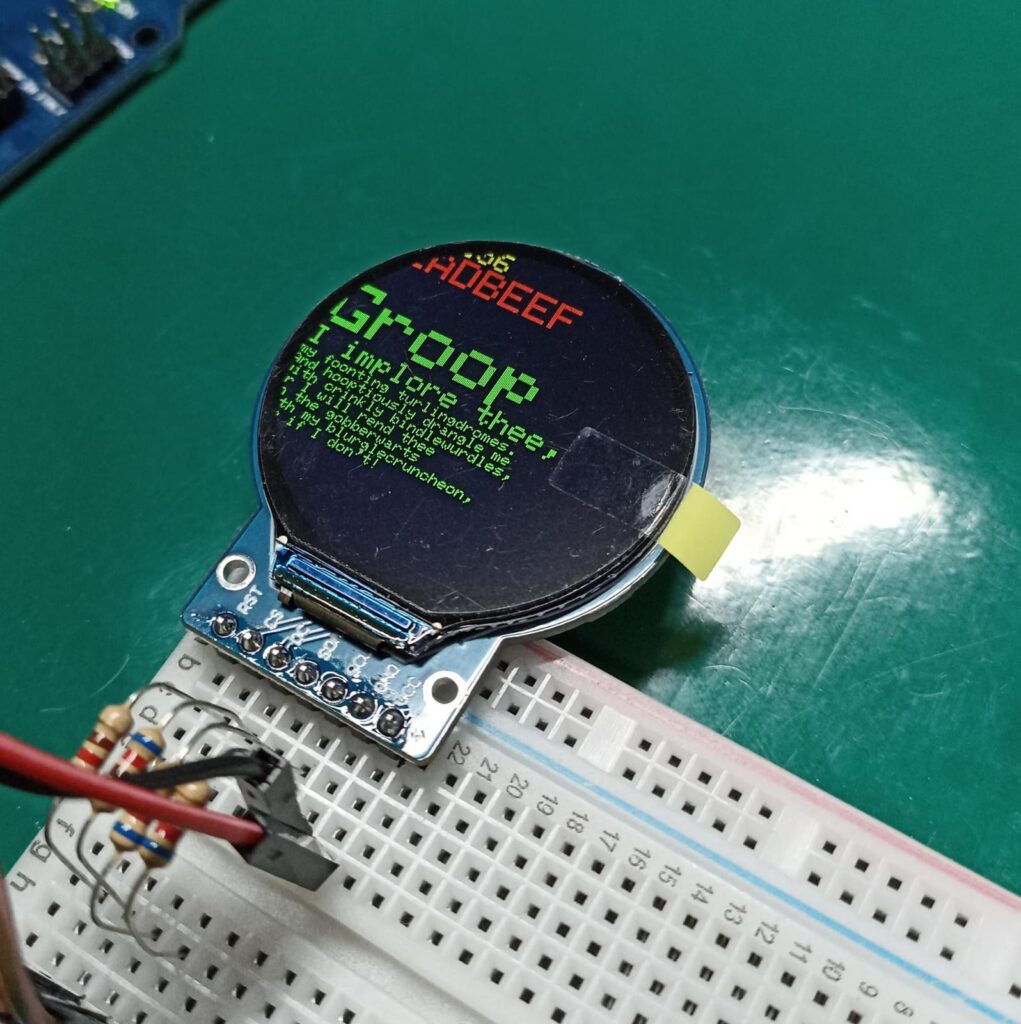
Then I made a simple code to show the blog URL, as seen below. It is based (and using) on the Adafruit library.
#include "SPI.h"
#include "Adafruit_GFX.h"
#include "Adafruit_GC9A01A.h"
#define TFT_DC 9
#define TFT_CS 10
Adafruit_GC9A01A tft(TFT_CS, TFT_DC);
void setup() {
// put your setup code here, to run once:
tft.begin();
tft.fillScreen(GC9A01A_BLUE);
yield();
tft.setCursor(30, 100);
tft.setTextColor(GC9A01A_GREEN);
tft.setTextSize(3);
tft.println("FritzenLab");
tft.setCursor(90, 120);
tft.println(".net");
}
void loop() {
// put your main code here, to run repeatedly:
}The end result is pretty neat:
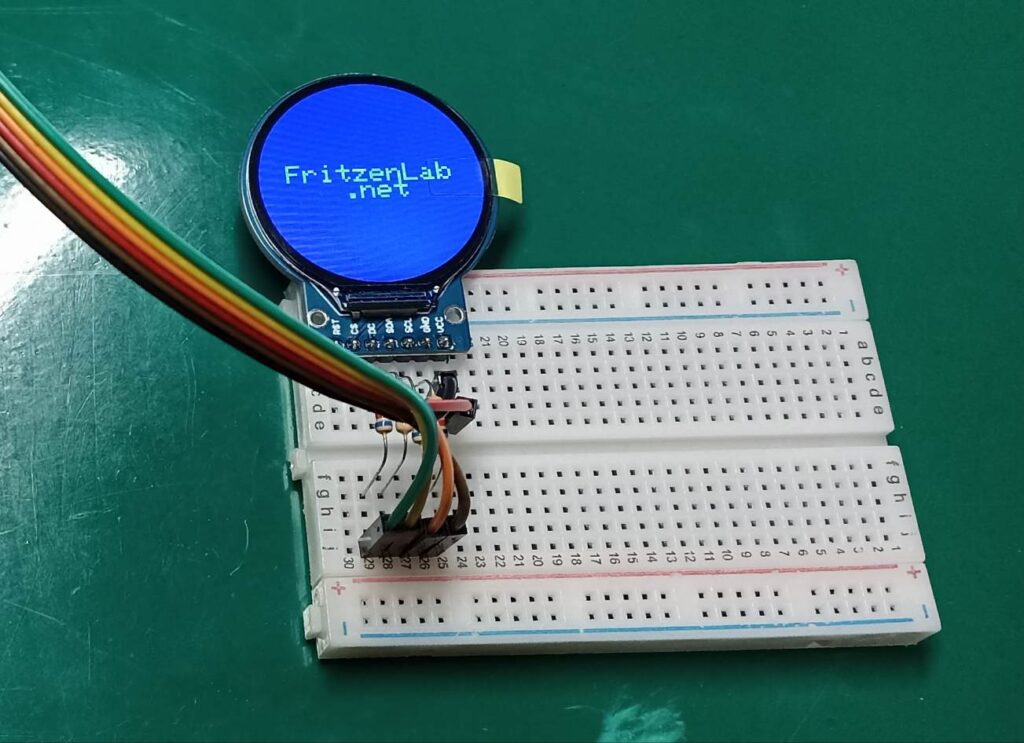
I also improved it a bit by animating the text, as seen in the video below:
#include "SPI.h"
#include "Adafruit_GFX.h"
#include "Adafruit_GC9A01A.h"
#define TFT_DC 9
#define TFT_CS 10
Adafruit_GC9A01A tft(TFT_CS, TFT_DC);
void setup() {
// put your setup code here, to run once:
tft.begin();
tft.fillScreen(GC9A01A_BLUE);
yield();
}
void loop() {
// put your main code here, to run repeatedly:
for(int i=0; i < tft.height(); i=i+10){
tft.setCursor(30, i);
tft.setTextColor(GC9A01A_GREEN);
tft.setTextSize(3);
tft.println("FritzenLab");
tft.setCursor(90, i+20);
tft.println(".net");
//delay(10);
tft.fillScreen(GC9A01A_BLUE);
}Final word
Despite not being the fastest display ever it can do a bit of animation. We have seen that in the Gauge/meter example and also in the Adafruit demo. Looking at it feels nice, different from so many display I have seen around. Will definitely do a project with it in the future.
Want to know more abou displays? I just recently wrote about the 0.96″ OLED i2c one, here. Also if you want to buy your own display for testing, buy the GC9A01A from my Banggood affiliate link.


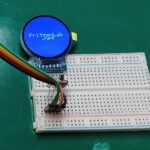

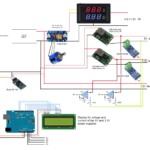
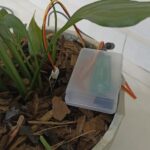
Leave a Reply